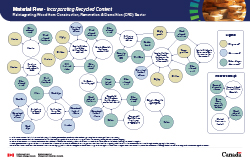Material flow: Reintegrating Wood from CRD Sector - Incorporating recycled content

Download the alternative format
(PDF Format, 168 Kb, 1 page)
The diagram depicts the material flow of incorporating recycled content using wood recovered from the construction, renovation and demolition (CRD) sector. This diagram focuses on the 15 categories of products into which recycled lumber is incorporated. The examples listed are representative and not exhaustive of the current commercial activities in Canada based on sources such as websites, site visits or reports. Activities must be in accordance with domestic requirements (e.g. legislation, codes).
The sources illustrated in yellow are for dirty wood, blue are for clean wood, and green represents where the current commercial activities do not specify whether the wood material is dirty or clean, or indicate that any type of wood is accepted. Dirty wood represents wood material that may contain glue, paint, stains, preservatives, additives, metal fasteners (e.g. engineered wood - particleboard, glulam). Clean wood represents wood material that does not contain contaminants (e.g. paint, stain, chemicals, or glue), but the wood may be pierced (with nails, screws, staples).
- Flooring is re-used as is from reclaimed flooring or remanufactured from wood salvaged from barns or other salvaged wood.
- Furniture (e.g. tables, stools cupboards, beds) is re-used as is from reclaimed furniture, and manufactured from flooring, wood salvaged from barns or other salvaged wood.
- Exterior Finishes (e.g. shiplap, cladding, decorative architrave) are manufactured from dimensional lumber / off-cuts, shiplap, cladding, nail-laminated timber, wood salvaged from barns and other salvaged wood.
- Exterior Materials (e.g. fences, outdoor decks) are manufactured from wood salvaged from barns and other salvaged wood.
- Cabinetry (e.g. kitchen cabinets) are manufactured from 3/5 ply panels from wood salvaged from barns, other salvaged wood, as well as particleboard and decorative panels / MDF that are produced from wood fibre.
- Interior finishes for residential purposes (e.g. feature walls, hollow beams, ceiling, mantels) are manufactured from wood salvaged from barns, other salvaged wood, veneer paneling, cladding, shiplap, and dimensional lumber / off-cuts.
- Interior finishes in restaurants/ bars (e.g. accent walls, bar counters) manufactured from wood salvaged from barns and other salvaged wood.
- Set design (e.g. walls, props) is manufactured from finger-jointed lumber produced from other salvaged wood.
- Agricultural applications (e.g. livestock bedding) are manufactured from pallets, as well as wood fibre and wood chips produced from dimensional lumber / offcuts.
- Landscaping (e.g. mulch, ground cover) materials are manufactured from wood chips, sawdust, and dimensional lumber / off-cuts.
- Household small products (e.g. library boxes, stools, wine racks, art) are produced from dimensional lumber / off-cuts, pallets, wood salvaged from barns and other salvaged wood.
- Commercial small products (e.g. signage, product display shelves) are manufactured from other salvaged wood and pallets.
- Shipping materials (e.g. reused / repaired pallets) are manufactured from reclaimed pallets.
Currently reclaimed lumber is most often used in non-load-bearing, non-structural applications with the exception of those listed as a proof of concept.
Proof of concept
- Structural, load bearing building materials manufactured from reclaimed lumber are made from beams, floors, trusses in commercial buildings and structural elements in a house.
- Musical instruments (e.g. guitar) are manufactured from wood salvaged from barns.
The majority of salvaged wood described above from renovation, demolition and deconstruction projects are reclaimed old growth wood and are post-consumer.